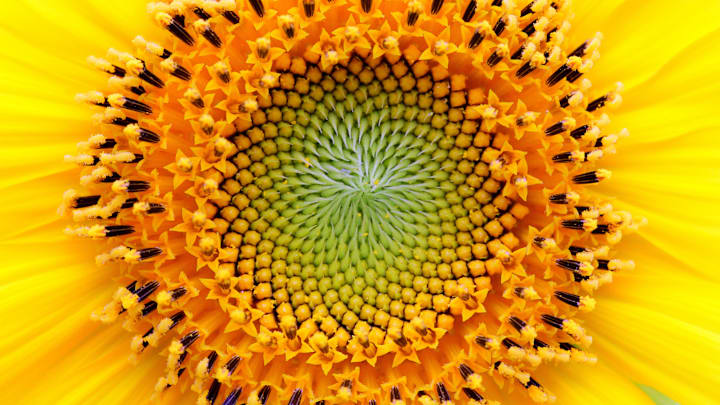The Fibonacci sequence is a series of numbers in which each digit reflects the sum of the two preceding numbers. Italian mathematician Leonardo Bigollo Pisano (known as Fibonacci) introduced his sequence in the 1202 book Liber Abaci. Though he developed the theory to calculate rabbit population growth, the sequence is in everything from cabbages to music to ocean waves. It can also be found in the form of the golden ratio, also known as Phi and expressed numerically as 1.618. Here are several places where you can see the Fibonacci sequence.
1. Art and Architecture
Some of the world’s best-known buildings use the golden ratio. You can see Fibonacci’s influence in the Taj Mahal, the Parthenon, and Notre Dame. Beyond architecture, it's in graphic design and art as well—because it’s considered to create harmony and be a pleasing visual, many companies have the golden ratio into their logos. This includes Pepsi, Twitter, Apple, BP, and Toyota. Leonardo da Vinci’s Mona Lisa has also been linked to the golden ratio, and Michelangelo’s works in the Sistine Chapel incorporate more than 24 uses of it.
2. Botany

Many flowers have petals that add up to Fibonacci numbers, including buttercups, daisies, marigolds, delphiniums, black eyed Susans, and lilies. Rose petals are actually arranged in a Fibonacci spiral—the relationship between any two adjacent petals will equal 1.618. The Fibonacci sequence is perhaps most easily observed in the sunflower, where the seeds form an obvious spiral pattern. Look for it beyond flowers, too: It's in plant leaves and branches, and you can find the mathematical sequence in the spiral on the bottom of pinecones and in the circular pattern of tree rings.
3. Animals

The Fibonacci sequence is common in the animal kingdom. The starfish has two manifestations of Fibonacci: It has five arms (a Fibonacci number), as well as a pentagon shape that reflects the golden ratio. Other examples are the horns of a ram, the tail of a seahorse, and the shells of snails and the nautilus. A particularly impressive example of the Fibonacci sequence can be found in the reproduction pattern of bees. Male honey bees, called drones, only have one parent; their family tree reflects a Fibonacci number at each level of ancestors.
Even the body proportions of certain animals, such as sea urchins, ants, and dolphins, follow the sequence. You can see it in action, too: The flight pattern of a falcon attacking its prey follows the spirals reflected in a Fibonacci pattern.
4. The Financial Market
Traders use multiple applications of the sequence in the financial markets. These include Fibonacci retracements, arc, time zones, and fans. Retracements are created when the distance between two points on a stock chart is dividing by certain Fibonacci ratios—which include 38.2 percent, 50 percent, and 61.8 percent. Arcs are used to find possible support, resistance, or reversal points. Traders use Fibonacci Time Zones to separate time periods into smaller amounts of time, the lengths of which are consecutive Fibonacci numbers.
5. Space
Fibonacci’s discovery can even be found beyond the Earth, in the solar system. The relationship between the diameter of Saturn and the diameter of its rings is a ratio extremely close to Phi. The time it takes some planets (including Jupiter, Earth, and Mercury) to orbit the sun also appears to have a relationship to Phi. Spiral galaxies such as the Milky Way, Galaxy M81, and the Andromeda nebula all resemble the golden spiral. There’s even a theory put forth by South African researchers that the golden ratio is found so often because it is a property of space-time itself.
6. Ourselves
Yes, Fibonacci is even reflected in the human body. The shape of an ear and a clenched fist exhibit the spiral associated with the Fibonacci sequence. Our extremities have other examples of the sequence, too: We have two hands with five fingers (both Fibonacci numbers), and the sections of our fingers are each larger than the preceding section, from the fingertip to the wrist. Human faces whose segments have the golden ratio proportions are considered more beautiful. The closer the sections are to equal numbers, the closer they are to the golden ratio.
